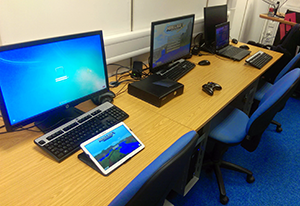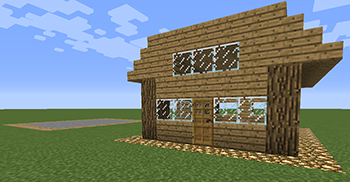
The Experiment
To test this hypothesis a game was needed to fulfil the 3D game world requirement. This was a difficult task as there are few games that have versions with all three input methods. Minecraft was the ideal choice as most participants have a familiarity with it, and it also met the input requirements. However there were some issues as the three versions of Minecraft are not at the same state of development, meaning some lack certain features, which meant we couldn’t easily make the test scenario identical.
The test needed to limit external factors that could interfere with the test, such as monsters spawning, weather changes and the day/night cycle. Some versions could disable these and others couldn’t. Monster spawning could be disabled on all but the tablet version, which was fixed through a mod that added this functionality from the PC version. Weather changes couldn’t be turned off on most of the platforms so was left on as it isn’t a major problem. The day/night cycle couldn’t be turned off, which meant some participants could be playing in the dark while others in daylight. To counter this the brightness for all version was turned to max and lights covering the test area. This made sure the area would look the same day or night.
The next task was setting up a building challenge where the participant had to recreate a building based on one already present in the Minecraft World. They were provided all the resources required to build it, plus spares to fix any mistakes. A 5 second penalty would be applied for any mistakes made and not corrected before the timer was stopped, if the amount of mistakes made are above a certain threshold (more than ten) the test would be void and restarted. The worlds were recreated exactly in each version so there would be no flaw in the test that could cause a bias.
To eliminate a potential source of bias the experiment had to be run in a different order for every participant. This was to balance out the participant getting better at completing the task on each subsequent test, which would mean that the input method used for the last experiment would have a higher advantage. The equipment would also remain the same, and no setting would be changed during or between experiments to avoid any bias.
To get accurate results for the experiment a reasonable sample size was required to allow for differences in the participants’ skills in games and/or Minecraft. It also needed to be a multiple of six, as that was how many order variations were required to remove the starting bias.
Before each test the supervisor will give the participant a survey and ask them to fill out question one, which asks them which input method they prefer. Then the participant will be given a chance to look at the building they need to recreate. During this period the supervisor will explain the rules of the experiment. They can also explain the control scheme and the basics of how to play Minecraft if the participant is unfamiliar.
The stopwatch will be started when the participant places their first block. During the test the supervisor will tell the participant if they have made a mistake and will help remind them of the desired structure. This is fine as the experiment is not measuring the participants’ memory. The timer is stopped once the supervisor deems the structure complete, any mistakes discovered after this point will be penalised.
The participant will then repeat this process for the other two input methods until the times for all three experiment have been measured. At this point the rest of the survey will be completed. Participant data will be kept anonymous, and times will be linked to surveys by a unique participant number.

